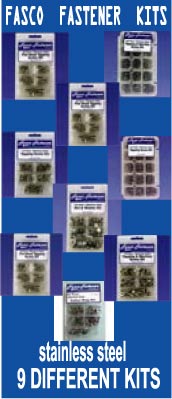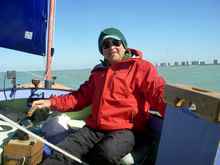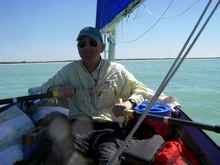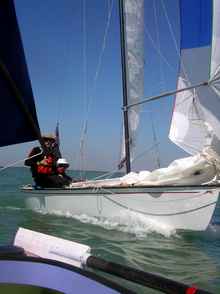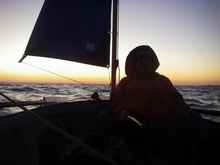
 Custom Search
|
| sails |
| plans |
| epoxy |
| rope/line |
| hardware |
| canoe/kayak |
| sailmaking |
| materials |
| models |
| media |
| tools |
| gear |
| join |
| home |
| indexes |
| classifieds |
| calendar |
| archives |
| about |
| links |
| Join Duckworks Get free newsletter CLICK HERE |
|
|
| The Everglades Challenge - 2013 |
by Gary Blankenship
- Talahassee, Florida - USA with comments in italics by Chuck Leinweber |
| Part 3: Day 3 part 1 - part 2 - part 4 - part 5 We awoke before sunrise and found a light northeasterly. A careful observation was made of New Pass. There were continuous breakers on the south side, but on the north it was mostly clear in a channel marked by a couple red buoys. We could see an occasional small breaker further out. I was thankful we weren't trying to leave in a strong onshore wind. We breakfasted, struck camp, swung the stern of the boat around so the bow pointed to the water, and launched with the reddish sunrise behind us.
We avoided breaking waves on the way out, but swooped over a couple that were about to tumble. Once clear of the breakers we headed south with a steadily increasing wind. After an hour or so, it rose more and we put a reef back in the main. At some point we scooted by Wiggins Pass but I didn't see it. Subsequent reports showed there were a large number of fellow Watertribers - all kayakers I think - there the previous night. Wiggins is as far south as one can go on the inside route. After that, it's outside into the open Gulf until at least Gordon Pass or more likely Big Marcos. A video posted by Ben Algera (Macatawa) showed that Wiggins seems a lot like New Pass, with rolling waves humping up and occasionally breaking.
Soon Doctors Pass slid by, but the wind began to ease as Gordon Pass approached. Unreefing the main only seemed to encourage a further absconding. It was a repeat of the first two days where winds blew from east of north, sometimes boisterously, in the morning and then eased toward noon to be followed by a northwest wind. In this case, it took around two hours for the changeover as our speed dropped from nearly 5 knots to 2.5 to 3. Just past Gordon, it almost completely died and Chuck broke out the oars to row, before the new wind finally filled in. But the slow passage gave us a chance to study Gordon from offshore, which has a bad reputation among Watertribers. We could see why. The northern side of the inlet had continuous breakers, even in the calm seas of that morning. The south side had the marked channel and a stream of powerboats were heading in an out. We didn't know it at the time, but Gordon lived up to its reputation that year as veteran Watertriber Nick Hall, with his nephew, lost their Hobie Tandem Island trying to enter Gordon. They were able to reach shore uninjured. Shortly after passing Gordon we were treated to a replay of our time warp vision of the previous day. Only this time it was two of the caravel/galleons entering Gordon. We found out after the EC that the replicas of Columbus' famous ships, the Nina, Pinta, and Santa Maria, were on tour in the area and that's undoubtedly what we saw.
They also seemed to bring wind as the northwesterly filled in and sent us south at between 4.5 and 5.5 knots. It was pleasant sailing. We didn't need to reef, and there were usually other Watertribers in sight. We filmed Jeff Prideaux (Clean Slate) in his Triak almost disappearing between the swells off Marco Island, and watched Tom Dyll (MicroTom) and Per Lorentzen (DonKeyHoTey) pass us on their Lightning, having fixed rudder problems they had on the first day. Eddie Mack (Coastie) and Joshua Murphy (ClamCounter) on their Hobie Getaway were also in sight. The Lightning ducked in the Caxambas River on the south side of Marco Island (where development and civilization stops with the suddenness of an axe chop) while we headed for Cape Romano, figuring the steadier winds and slightly shorter distance might have us overtake the faster boat. (Fat chance - they beat us to Checkpoint 2 by three hours.) We also reckoned with a fairly easy time at Romano, arriving at high tide and in daylight. We approached the cape at 4 p. m. with its funky abandoned house on the tip and observed a huge shoal just to the south, above even the high water. I calculated it was exactly where I had sailed in the 2012 EC - without striking anything with the leeboard. That's a testament to how fast the shoals can shift. Shifting or not, Cape Romano was in a beneficent mood this year. We only had to alter course once to miss a shallow area and never even grazed our slightly lowered centerboard. The wind remained northwesterly and moderate, and it and the lowering sun chased us across Gullivan Bay toward Indian Key Pass, the last obstacle to Checkpoint 2.
I think of the second stage of an Everglades Challenge as three parts. The preamble is getting to and across Charlotte Harbor and then down Pine Island Sound. That sets up the main part, the 40 mile slog from Sanibel to Cape Romano. But you're not home once getting to the cape. There's still 13 or 14 miles to get to Indian Key Pass and then negotiating that intricate passage with its strong tidal flows. It was those tidal flows that had our interest now. The following wind was making the trip to Indian Key easy (the shallow water can kick up a nasty chop in a headwind). But we weren't going to get there until a couple hours after high tide, which means we would face an outgoing current it we attempted the pass. The tentative plan was to stop on the northern side of Indian Key, rest for a few hours while waiting for the tide to change, and then ride the currents to Chokoloskee Bay and CP2. There we would get a few more hours rest waiting for the Tuesday morning outgoing tide. We elected to take the slight shortcut and go north of Indian Key to the pass and got there after sunset, in the last glimmerings of light. Since we still had a favorable wind, Chuck suggested seeing how far we could get and then find a place to beach or anchor. Seemed like a sensible suggestion, so on we went. We made it more than a third of the way before the wind, as it had every night so far, began to die and what was left was blocked by mangrove islands. Here we had a slight division of the wits. Chuck suggested we row just to see how strong the adverse current was. I was skeptical, having once challenged with oars a contrary tide in one of the passes leaving Chokoloskee. That left vivid memories of taking hearty strokes while watching the land scream by at, oh, six inches per stroke. But Chuck insisted and took the first 30-minute stint, Contrary to my fears, we kept up almost a 2 mph average, good enough to keep going. The last, narrow stretch before Chokoloskee Bay focused the tide, but we still managed almost 1.5 mph. Once a few hundred yards into the bay, we were able to angle south of the channel and then, freed from the current, our speed picked up to 3 mph. We had a pleasant pull in the flat calm to CP 2, where my last fear was alleviated. We landed just after 11 pm at about half tide on the firm sand beach, before the lowering tide exposed the infamous Choko mud. My part of our collective wit bowed to Chuck's part in admiration. A bit more careful reading of the tide tables would have revealed why we succeeded as masters of the tide. I was spooked by the succeeding incoming tide, which featured a four foot change (that's a lot for these parts) in water height at Indian Key and surely generating those fearsome tides for which the area is famed. But the outgoing tide we were bucking had only a bit more than half that change, which meant easier currents. Also, the tides at Chokoloskee are two hours later than Indian Key, which gave us more time to avoid the mud at the beach, and also meant we may have missed the worst of the adverse tide at the end of the channel.
The reward for Chuck's perseverance was we now had a long break before we could leave with the morning high tide, which came around 10 am. We signed in and stretched our legs. We debated about setting up the tent on the beach, but decided to sleep under the stars. There was one other person in a bedroll on the beach. It turned out to be Toby Nipper, who was running the second checkpoint. He had elected to forego his warm motel room and sleep on the beach so he could meet incoming competitors - as we tiptoed around so we wouldn't wake him. Chuck chose to sleep in the open, while I spread my bedroll under a bushy tree, wary of the dew. The temperature headed back into the cold zone as we drifted off to sleep.
Next time: Days 4&5 Here is a video montage with clips from the entire EC: |
|
